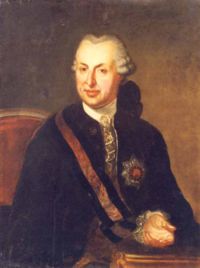
Samuel von Brukenthal
Encyclopedia


Habsburg Monarchy
The Habsburg Monarchy covered the territories ruled by the junior Austrian branch of the House of Habsburg , and then by the successor House of Habsburg-Lorraine , between 1526 and 1867/1918. The Imperial capital was Vienna, except from 1583 to 1611, when it was moved to Prague...
governor of the Grand Principality of Transylvania
Transylvania
Transylvania is a historical region in the central part of Romania. Bounded on the east and south by the Carpathian mountain range, historical Transylvania extended in the west to the Apuseni Mountains; however, the term sometimes encompasses not only Transylvania proper, but also the historical...
between July 6, 1774 and January 9, 1787. He was a baron
Freiherr
The German titles Freiherr and Freifrau and Freiin are titles of nobility, used preceding a person's given name or, after 1919, before the surname...
of the Holy Roman Empire
Holy Roman Empire
The Holy Roman Empire was a realm that existed from 962 to 1806 in Central Europe.It was ruled by the Holy Roman Emperor. Its character changed during the Middle Ages and the Early Modern period, when the power of the emperor gradually weakened in favour of the princes...
, and personal advisor of Empress
Holy Roman Emperor
The Holy Roman Emperor is a term used by historians to denote a medieval ruler who, as German King, had also received the title of "Emperor of the Romans" from the Pope...
Maria Theresia.
His home, a large palace in Sibiu, is currently home to the Brukenthal National Museum
Brukenthal National Museum
The Brukenthal National Museum is a museum, erected in the late of 15th century in Sibiu, Romania, housed in the palace of Samuel von Brukenthal — who was Habsburg governor of Transylvania and who established its first collections around 1790...
(formed around the collections he gathered, and expanded from a public exhibit first opened in 1817).
Life
Samuel von Brukenthal was born on 26 July 1721 in Leschkirch (Romanian: NocrichNocrich
Nocrich is a commune in Sibiu County, Romania, in the region of Transylvania. The commune is situated between Agnita and Sibiu. It is composed of five villages: Fofeldea, Ghijasa de Jos, Hosman, Nocrich and Ţichindeal. Nocrich and Hosman have fortified churches.It is the site of the St...
), between Sibiu and Agnetheln. His grandfather and father had been royal judges. He started the construction of the palace a year after being elected governor of Transylvania (1777). The major difficulty in the construction of the "new house" consisted in the obligation to keep to the two demolished lots, the church and the Jesuit seminary. Unlike palaces surrounded by parks, the edifices built in the interior of the medieval towns are strictly limited to the existence of the initial lots. The palace built by Samuel von Brukenthal has a rectangular foundation, enclosing an inner courtyard. The access to the palace and to the courtyard is made through a portal situated in the axis of the narrow side, towards the front of the street.
The Brukenthal Palace in Sibiu represents one of the Baroque treasures in Central Europe. The construction of this imposing edifice had as no other purpose, from the very beginning, than the creation of a propitious background for the conservation of an art collection and of antiquities having an inestimable value.
Legacy
There was not only the palace named by him, also a school which is situated near the palace, right across the Protestant Cathedral. Samuel von Brukenthal is the oldest German school in Romania. The school was mentioned the first time in 1380. The present building was erected in the 18th century. The school is named by the former governor of Sibiu and the lover of Maria Theresa of Samuel Brukenthal. The Samuel von Brukenthal Gymnasium (Sibiu, Romania) is a school with instruction in the language of the German minority. The school is still one of the best schools in the country. The language is still German, Romanian is only taught as a foreign language. After the turn of the twentieth century and the exodus of the Transylvanian SaxonsTransylvanian Saxons
The Transylvanian Saxons are a people of German ethnicity who settled in Transylvania from the 12th century onwards.The colonization of Transylvania by Germans was begun by King Géza II of Hungary . For decades, the main task of the German settlers was to defend the southeastern border of the...
, the majority of students are Romanians.

